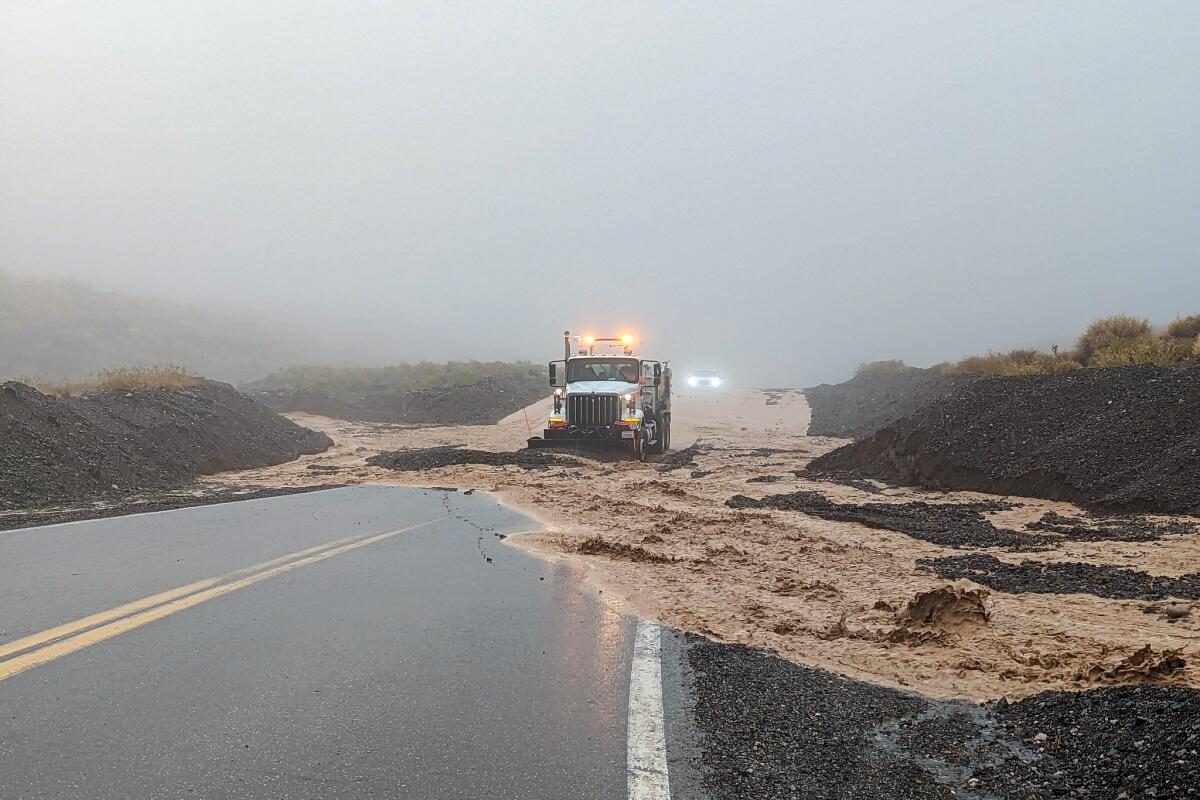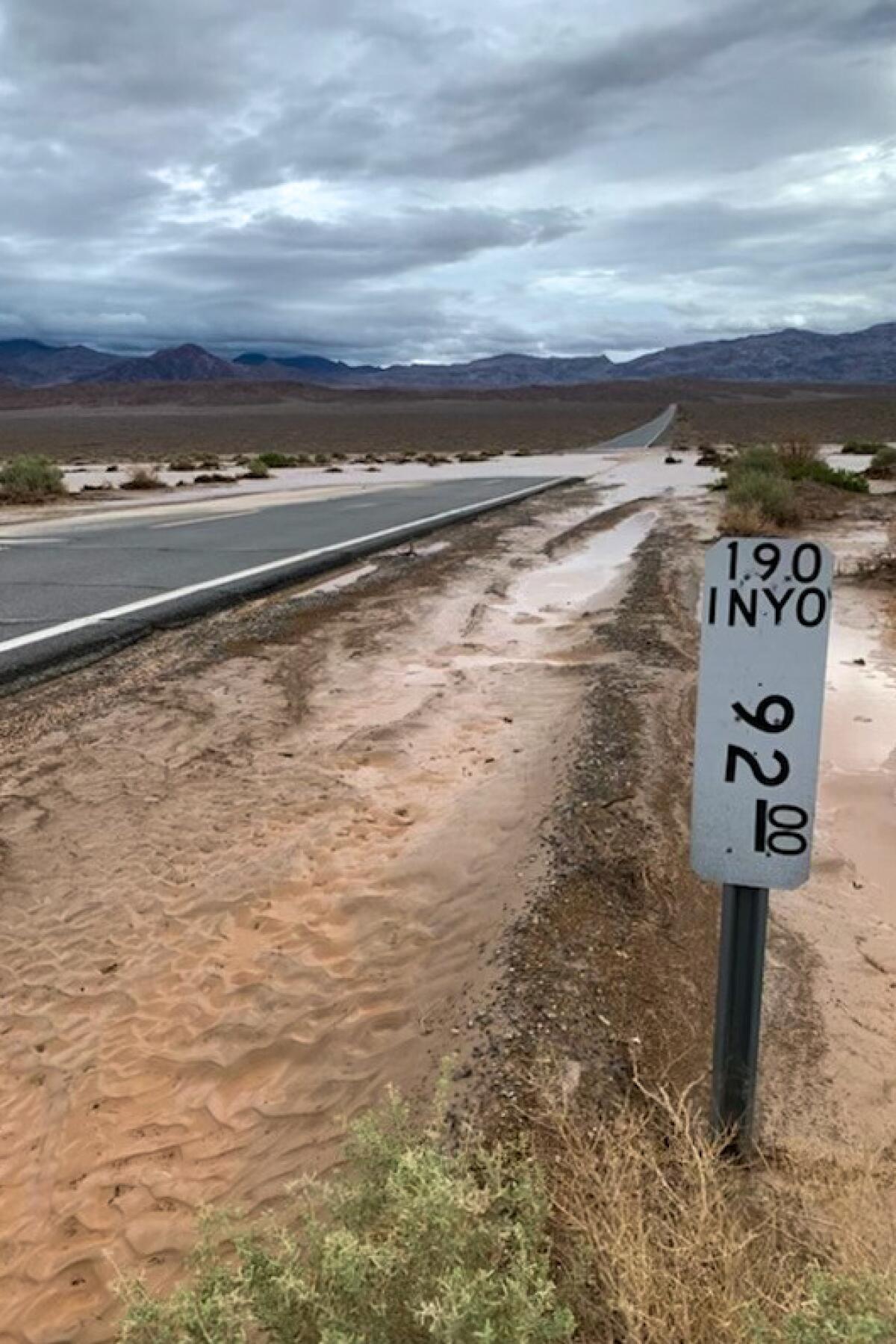Sign up for The Wild
We’ll help you find the best places to hike, bike and run, as well as the perfect silent spots for meditation and yoga.
You may occasionally receive promotional content from the Los Angeles Times.
Sunday’s tropical storm didn’t just close Death Valley National Park — it also isolated hundreds of residents, visitors and workers when floodwaters shut down California 190 and other park roads.
By 12:10 p.m. Monday, park management analyst Abigail Wines said, “We are optimistic we will have an exit route by this evening. Caltrans is amazing.”
Three hours later, Wines reported that crews had cleared a path so that an ambulance could get through on 190, if necessary — but no non-emergency vehicles were allowed to pass. Visitors probably won’t be able to drive out until Tuesday, Wines said.
Tropical Storm Hilary blew past daily rainfall records across Southern California, “just smashing” records across L.A. and Ventura counties.
Wines guessed that about 400 people were effectively stranded within the park on Sunday, when Tropical Storm Hilary dropped 2.2 inches of rain — the wettest day on record, by count of the National Weather Service. The NWS has said the park typically gets less than 2 inches per year.
That storm also cut power for about a day. “We just got power back about an hour ago,” Wines said shortly after 3 p.m.
Wines added that the park’s restaurants were operating. Employees at the Oasis at Death Valley and Stovepipe Wells, two of the park’s busiest dining and lodging areas, said they had been instructed not to talk with media.

Meanwhile, at Joshua Tree National Park, which shut down Saturday in anticipation of heavy rain and flooding, rangers said the park would reopen Tuesday for day use only, and no camping. A spokesman said that all visitor centers and paved roads would be open but that all dirt roads and campgrounds would be closed “until further assessment can be done.”
At Death Valley, Wines said the California Highway Patrol had a plane flying over the park, checking for any stranded people. As of midday, she said, Badwater Road and Harry Wade Road appeared to be clear of people. A National Park Service plane was expected to join that effort on arrival from Lake Mead National Recreation Area.
In the effort to reopen California 190, the National Park Service is clearing the highway from Furnace Creek to Stovepipe Wells, Wines said, while Caltrans is clearing the route from Furnace Creek to Death Valley Junction.

When that’s done, Wines said in an email, “we (residents, employees, and the visitors here) will have an exit route.”
Wines said a park contractor reached Scotty’s Castle on Monday morning and reported “only minor impacts.” The castle, long a favorite spot for Death Valley tourists, has been closed since 2015, when it was heavily damaged in another flood. After years of repairs, a reopening was tentatively set for late 2025.
As for the reopening of the park, Wines said, “I don’t have enough info about damage to be able to guess when the park will start reopening. It will certainly be in sections.” Later, she added that it would probably be “several days before anyone’s allowed in.”
The National Weather Service predicted a 50% chance of rain at Death Valley on Monday, falling to 20% in the evening with a “slight chance of thunderstorms.” A high of about 90 is expected at Furnace Creek.
The National Weather Service said flooding was likely to affect areas including Stovepipe Wells, Furnace Creek, Shoshone, Texas Springs Campground, Panamint Springs, Darwin, Mesquite Springs Campground, Scotty’s Castle, Death Valley Junction and Tecopa.
Sign up for The Wild
We’ll help you find the best places to hike, bike and run, as well as the perfect silent spots for meditation and yoga.
You may occasionally receive promotional content from the Los Angeles Times.